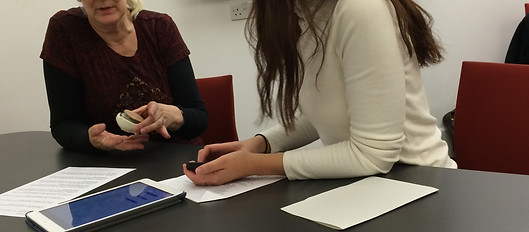AwareMe: an Assistive Technology for Fear of Public Speaking
CHI '16 Student Design Competition Finalist

Techniques Used
Participant Observation Prototyping Brainstorming
Semi-Structured Interviews Personas Storyboarding
User Evaluation Wizard of Oz
This team project is the culmination of a MSc in Human Computer Interaction module. AwareMe incorporates aspects of Cognitive Behavioral Therapy (CBT) and good public speaking practices to make an empowering assistive technology for people who suffer from different levels of public speaking anxiety. AwareMe was a Finalist in CHI '16 Student Design Competition, and published as one of the top 12 papers.
We chose to design for glassophobics because it's a hidden disability. About 18% of American adults have anxiety disorders that cause fear of public speaking, but we have all probably encountered fear of public speaking before!
AwareMe Base
1) Initial Training Mode
AwareMe detects your speech patterns and recognizes your optimal speaking voice & pitch through machine learning technology.
2) Practice Mode
Complete optional breathing exercise to lower your adrenaline, proven to calm based on Cognitive Behavioral Therapy.
Set presentation time length, and practice until you're ready and confident. AwareMe provides personalized feedback & advice on:
Words Per Minute (speed)
Filler Words (non-fluencies)
Pitch (nervousness)




Time Management
The base changes colors from green, then to yellow and red during the last portion of your presentation. This allows you to pace yourself and deliver all material, while staying within an allotted time frame.
AwareMe Wristband
3) Presentation Mode
Worn during presentations, the Wristband provides colored indicator to reminds you how much time is left. Colors appear on the underside of the Wristband for discreetness.
Based on our user evaluation feedback, AwareMe Wristband provides optional haptic feedback for the following:




Speaking Too Fast?
Slow, smooth vibrations remind you to slow down your pace
Speaking Too Slow?
Fast, smooth vibrations remind you to pick up your pace
Time Left
One short vibration signifies you’re in the yellow and two short vibrations signifies you’re in the red
Users can turn haptic feedbacks on / off.

Approach
We wanted to avoid designing an assistive technology that attempted to replace Cognitive Behavioral Therapy (CBT), the only proven solution for glossophobia. Our approach differs from existing solutions because it focuses on bringing the users’ attention to how their anxiety influences their speech patterns; this awareness helps them to directly improve their public speaking skills.
Design Process
Research Sprint 1: Semi-Structured Interviews
Each team member conducted two semi-structured interviews. The 10 total participants ranged from confident public speakers to very nervous public speakers.
Data Analysis
An affinity diagram was used to organize our data and to allow themes to emerge. We recorded emotions, thought processes, and bodily changes participants experience when they have to give presentations. We noticed participants spoke about their anxieties in three steps: pre-presentation preparation, during presentation, and post-presentation review.

Research Sprint 2: Participant Observation

I attended a Toastmasters meeting to participant and observe techniques for improving speech deliveries. Novice and experienced speakers practiced body language and vocal pacing. Toastmasters use a physical stop light, placed at the back of the room, to help speakers keep time. This timekeeping technique was incorporated into our design.

Other team members attended a “Public Speaking for Beginners” meeting, where they learned more about non-verbal communication.

The team interviewed a therapist specializing in Cognitive Behavioral Therapy (CBT), a proven method to cure anxiety disorders associated with glossophobia. We learned fear of public speaking is usually linked to other social anxieties and cannot be easily or quickly cured with technology. We decided to incorporate CBT aspects into our design instead of replacing it.
User Requirements Derived from Data Analysis
Discreet
Participants indicated they want a device as discreet and inconspicuous as possible for the user and audience. Otherwise, their fear of speech would be exposed to their audience.
Focus on Practice
Most interview participants stated they spend most time on preparation, and this step allows for the user to improve their public speaking skills. However, we were still interested in designing a wearable piece for during-presentations, so users could receive haptic feedback and analyze their data post-presentation.
Multi-Situational
We learned from our interviews with participants and CBT therapist that there are many forms of public speaking that cause stress. Sometimes a one-on-one interview may appear more daunting than performing in front of thousands of people. Our design had to accommodate for all types of public speaking.
Ideation: Brainstorming
We conducted three rounds of brainstorming to generate as many inhibited, alternative ideas as possible. An elaboration and reduction design process followed.
Ideation: Sketches, & Storyboards
We came up with several ideas involving gamification, wearables, virtual reality, breathing devices, and others. Sketches were made into storyboards, and tested with 10 participants to gain feedback. Two samples of our storyboards:




Beany
A breathing device that prompts deep controlled breathing to stabilize your CO2 levels and lower adrenaline before you begin any presentation practice or actual presentation. Articulation warm-ups help prime your voice.


Kinect Game
Public speaking practice such as
- Fun power posing exercises
- Karaoke-style pacing
- Annunciation exercises
- Whac-a-Mole” inspired eye contact exercise to establish eye
contact with the audience
The user would get history scores and incentives to continue practicing.
Prototyping: Physical and Digital

Our first form factor was a bag of rice with a bike light to stimulate color communication.

An Arduino was considered for an interactive prototype, but passed on due to the long configuration process.

A lo-fi prototype was chosen for user evaluation, so users could focus on look & feel: a balloon filled with clay that conforms to palm shape.
We used iOS POP (Prototyping on Paper) App to create a clickable interface.

We encouraged participants to Think Aloud while they were completing Tasks #1 & #2. Participants interacted with AwareMe interface on the iOS POP App. They "trained the device" to their voices, and were given 10 minutes to prepare and practice a speech with AwareMe. We conducted semi-structured interviews afterwards.
Research Sprint 3: User Evaluation
We tested on 5 Toastmaster members using a Wizard of Oz setup. We created three tasks to test the main functions of our device.
1. Train the Device
2. Start Practice Mode


3. Give a Speech with AwareMe Wristband
Participants then gave their prepped presentation, while wearing an armband with an iPhone to simulate AwareMe wristband. We used cellphone vibrations to mimic the wristband haptic feedback and a color changing app to indicate the remaining time. Participants received a vibration when they stalled or appeared nervous.


Changes from Feedback
While there were limitations to our Wizard of Oz prototype, we were able to convey the concept and collect invaluable feedback on how to improve AwareMe. We incorporated changes such as:
• Haptic feedback pings were used to signify how much time is left rather than anxiety notifications
• Participants stated they did not like the abrupt vibration pattern, so we decided on a soothing, sweeping pattern that will speed up or slow down
depending on the rate of speech
• Haptic feedback setting can be turned on / off depending on preference
Presenting at CHI '16 San Jose


Hyping up for Poster Presentation
Most Exciting Encounter, Meeting Jakob Nielsen
______________________________________
The Team
Wen, Ruiwen, Christine, Mark